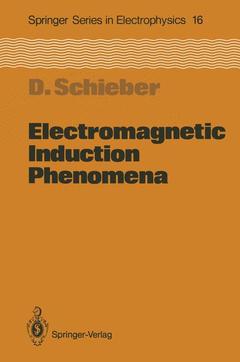Electromagnetic Induction Phenomena, Softcover reprint of the original 1st ed. 1986 Coll. Springer Series in Electronics and Photonics, Vol. 16
Langue : Français
Auteur : Schieber David

From an engineering perspective, Electrodynamics is the province of two cul tures. The most easily identified of the two is primarily concerned with phe nomena in which the propagation of electromagnetic waves is crucial. Includ ed are the designers of microwave circuits, of antennae and of many-wave length communication channels. The interests of the second group focus on dynamical processes associated with the evolution of field sources, whether these be electrons and holes migrating in a semiconductor, or currents diffus ing in a moving metal. Because the second culture is primarily concerned with the interaction be tween electromagnetic fields and media, where the latter are often responsible for the dominant dynamical processes, it addresses applications that are more widely ranging. A few from a very long list would include electrostatic print ing, rotating machines, power transmission apparatus, the electromagnetics of biological systems and physical electronics. Whether by nature or by de sign, the phenomena of interest are generally electro quasi static or magneto quasistatic in this second branch of electrodynamics. It is tempting to say that the two branches of electrodynamics can be distinguished by the frequency range, but electron-beam and microwave-magnetic devices, with their respec tive plasma oscillations and spin waves, are examples where the frequencies can be in the GHz range while the fundamental interactions are quasistatic. By design, so also are those that determine the frequency response of a transistor.
1. Introduction.- 1.1 Electrodynamics of Moving Media.- 1.2 Some Remarks on Electrodynamics of Moving Media and Restricted Relativity.- 1.3 Some Remarks on Quasistatics.- 1.4 “Cerenkov Electrodynamics”.- 1.5 Further Remarks on Quasistatics.- 1.6 Summary of Approaches.- 1.7 Outline of Contents.- 2. Principles of Magneto-Electric Interactions.- 2.1 Faraday’s Law in the Presence of Moving Media.- 2.2 Linear Induction Devices.- 2.3 Unipolar Induction — Basic Principles.- 2.4 Unipolar Induction — Extended Array.- 2.5 Optimal Dimensions for Braking Electromagnet.- 2.6 Unipolar Induction — Circular Motion.- 3. Electromagnetic Induction: Steady-State — Stationary Configurations.- 3.1 Eddy Currents in Thin Metal Sheets.- 3.2 Operation of Eddy Current Probe Coil.- 3.3 Proximity Effect Between a Plane Metal Screen and a Rectilinear Current Conductor.- 3.4 On the Inductance of Printed Spiral Coils.- 4. Electromagnetic Induction: Transient Phenomena — Stationary Configuration.- 4.1 Surge Impedance of Extended Grounding Rods.- 4.2 Field Transients in Saturable Cores.- 4.3 Field Switching in the Presence of Superconducting Material.- 4.4 Electromechanical Transients in Liquid Metal upon Field Disruption.- 5. Dynamic Phenomena.- 5.1 Wave Interaction with Moving Layers.- 5.2 Wave Propagation Inside Moving Nonmagnetic Media.- 5.3 Electrodynamics of Shielding: Cylindrical Configuration and Exterior Hertz Wave.- 5.4 Electrodynamics of Shielding: Spherical Configuration and Interior Fitzgerald Wave.- References.- Acknowledgement.
Date de parution : 11-2011
Ouvrage de 296 p.
15.5x23.5 cm
Thèmes d’Electromagnetic Induction Phenomena :
© 2024 LAVOISIER S.A.S.



